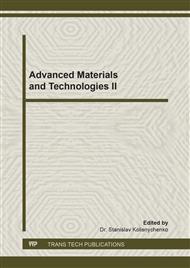[1]
C. J. Hibberd, Development of non-vacuum and low-cost techniques for Cu(In,Ga)(Se,S)2 thin film solar cell processing, Doctoral thesis, Loughborough University, UK, (2009).
Google Scholar
[2]
M. A. Green, K. Emery, Y. Hishikawa, and W. Warta, Solar cell efficiency tables (version 33), Progress in Photovoltaics: Research and Applications, Jan. 2009, Vol. 17, Issue 1, pp.85-94.
DOI: 10.1002/pip.880
Google Scholar
[3]
Report: IEA-PVPS T13-02:2014, Characterization of performance of thin-film Photovoltaic Technologies, PVPS-Photovoltaic Power Systems Programme, IEA-International Energy Agency, May 2014, ISBN 978-3-906042-17-6.
DOI: 10.1541/ieejpes.134.nl6_3
Google Scholar
[4]
S. Fonash, J. Arch, J. Cuiffi, J. Hou, W. Howland, P. McElheny, A. Moquin, M. Rogosky, T. Tran, H. Zhu, and F. Rubinelli, AMPS-1D Manual (BETA version 1.0), The Center for Nanotechnology Education and Utilization, The Pennsylvania State University, University Park, PA 16802, 2019 (Available at: http://www.empl.psu.edu/amps) (Last accessed on: Jan. 2019).
Google Scholar
[5]
N. I. Sarkar, Design optimization of a-Si:H p-i-n, µc-Si:H p-i-n, and micromorph tandem PV cell, MS thesis, Renewable Energy Tech., Institute of Energy, Univ. of Dhaka, Bangladesh, Oct. (2016).
Google Scholar
[6]
M. I. Kabir, S. A. Shahahmadi, V. Lim, S. Zaidi, K. Sopian, N. Amin, Amorphous Silicon single-junction thin-film solar cell exceeding 10% efficiency by design optimization, Int. J. of Photoenergy, Hindawi Publishing Corp., 2012, Article ID 460919,.
DOI: 10.1155/2012/460919
Google Scholar
[7]
M. Gloeckler, Device Physics of Cu(In,Ga)Se2 thin-film solar cell, Doctoral thesis, Dept. of Physics, Colorado State University, (2005).
Google Scholar
[8]
M. A. Matin, N. Amin, A. Zaharim, K. Sopian, Ultra thin high efficiency CdS/CdTe thin film solar cells from numerical analysis, NOLASC'09 Proceedings of the 8th WSEAS international conference on Non-linear analysis, non-linear systems and chaos, La Laguna, Spain, July 1-3, 2009, pp.338-344.
DOI: 10.1155/2010/578580
Google Scholar
[9]
M. A. M. Bhuiyan, M. S. Islam, A. J. Datta, Modeling, simulation and optimization of high performance CIGS solar cell, Int. J. of Computer Applications, Nov. 2012, Vol. 57– No.16.
Google Scholar
[10]
S. Sharma, K. K. Jain, A. Sharma, Solar Cells: In Research and Applications—A Review, Materials Sciences and Application, Dec. 2015, Vol. 6, pp.1145-1155.
Google Scholar
[11]
L. A. Kosyachenko, Solar Cells – Thin-Film Technologies, InTech, 2011, ISBN 978-953-307-570-9.
Google Scholar
[12]
D. E. Carlson, C. R. Wronski, Applied Physics Letters, 1976, Vol. 28, Issue 11, pp.671-673.
Google Scholar
[13]
Toward a Just and Sustainable Solar Energy Industry, A Silicon Valley Toxics Coalition White Paper, Jan. 14, (2009).
Google Scholar
[14]
A. Bensmain, H. Tayoub, B. Zebentout, Z. Benamara, Investigation of performance Silicon heterojunction solar cells using a-Si:H or a-SiC:H at Emitter layer through AMPS-1D simulations, Sensors & Transducers, May 2014, Vol. 27, Special Issue, pp.82-86.
Google Scholar
[15]
A. Mirkamali, K. K. Muminov, K. Kabodov, Speech Steganography in Wavelet Domain Using Continuous Genetic Numerical Simulation of CdTe thin film solar Cell with AMPS-1D, J. of Math. and Computer Sc., Jun. 2014, Vol. 11, p.231–237.
DOI: 10.22436/jmcs.011.03.06
Google Scholar
[16]
D. Y. Goswami, F. Kreith, Handbook of Energy Efficiency and Renewable Energy, CRC Press, May (2007).
Google Scholar
[17]
A. Luque, and S. Hegedus, Handbook of Photovoltaic Science and Engineering, 2nd ed., John Wiley & Sons Ltd., Mar. 2011,.
Google Scholar
[18]
M. M. A. Moon, M. F. Rahman, and A. B. M. Ismail, Optimization of active region thickness of CdTe/CdS Thin Film Superstrate Solar Cell to achieve ~25% efficiency: A simulation approach, Int. Conf. on Computer, Communication, Chemical, Materials and Electronic Engineering (IC4ME2-2018), Faculty of Engineering, Univ. of Rajshahi, Rajshahi, Bangladesh, Feb. 8-9, 2018,.
DOI: 10.1109/ic4me2.2018.8465600
Google Scholar
[19]
L. A. Kosyachenko, Innovative Elastic Thin-Film Solar Cell Structures, in: M. Sibinski, K. Znajdek, Solar Cells - Thin-Film Technologies, InTech, 2011, chap. 12, ISBN: 978-953-307-570-9.
DOI: 10.5772/22103
Google Scholar
[20]
X. Guo, Q. Tan, S. Liu, D. Qin, Y. Mo, L. Hou, A. Liu, H. Wu, Y. Ma, High-efficiency solution-processed CdTe nanocrystal solar cells incorporating a novel crosslinkable conjugated polymer as the hole transport layer, Nano Energy, 2018, Vol. 46, pp.150-157.
DOI: 10.1016/j.nanoen.2018.01.048
Google Scholar
[21]
H. S. Ullal, K. Zweibel, B. G. Roedern, Polycrystalline thin-film photovoltaic technologies: From the laboratory to commercialization, NREL 0-7803-5772-8/00, IEEE, (2000).
DOI: 10.1109/pvsc.2000.915857
Google Scholar
[22]
H. Ullah, B. Marí, H. N. Cui, Investigation on the effect of Gallium on the efficiency of CIGS solar cells through dedicated software, Applied Mechanics and Materials, 2014, Vol. 448, pp.1497-1501.
DOI: 10.4028/www.scientific.net/amm.448-453.1497
Google Scholar
[23]
P. Jackson, D. Hariskos, R. Wuerz, W. Wischmann, M. Powalla, Compositional investigation of potassium doped Cu (In, Ga) Se2 solar cells with efficiencies up to 20.8%, Physica Status Solidi (RRL)-Rapid Research Letters, 2014,.
DOI: 10.1002/pssr.201409040
Google Scholar
[24]
I. Bouchama, S. Boudour, N. Bouarissa, Z. Rouabah, Quantum and conversion efficiencies optimization of superstrate CIGS thin-films solar cells using In2Se3 buffer layer, Optical Materials, 2017, Vol. 72, pp.177-182,.
DOI: 10.1016/j.optmat.2017.05.056
Google Scholar
[25]
Absorption Coefficient in a variety of Semiconductor materials at 300K as a function of vacuum wavelength of light, (Available at: http://www.pveducation.org/pvcdrom/absorption-coefficient) (Last accessed on: Jan. 2019).
Google Scholar


